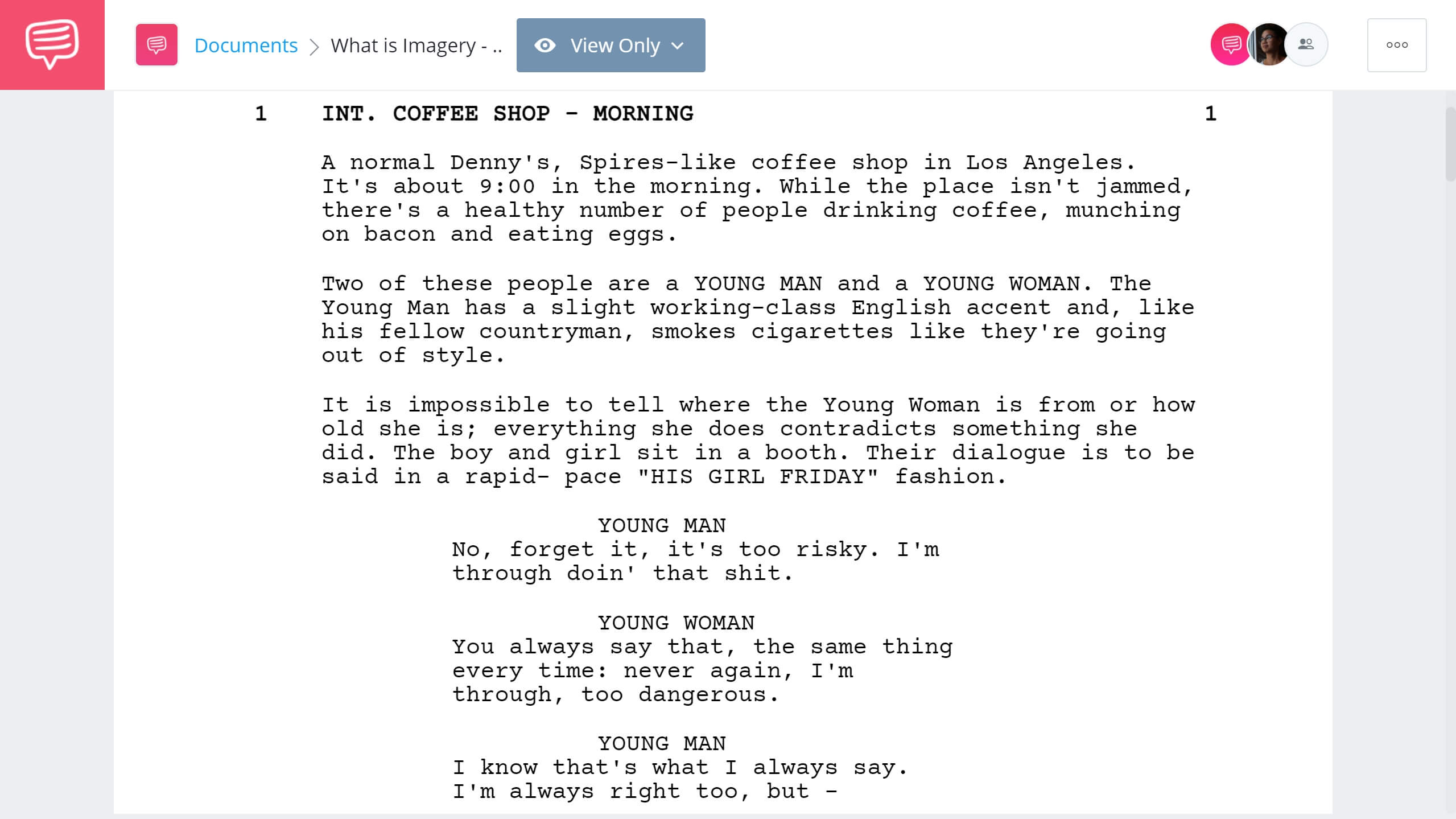Describing sensory experiences through the medium of writing and text can be difficult. By enlisting the use of imagery, writers are able to vividly describe experiences, actions, characters, and places through written language. What is imagery exactly. How is imagery in poetry and literature used? In this article, we’ll take a look at the imagery definition, seven different types of imagery and how each can be used to further immerse a reader into the work of a writer.
Imagery definition
First, let’s define imagery
Although there are several types of imagery, they all generally serve a similar function. To better understand the function of imagery in poetry and literature and how it can be achieved through various other literary devices, let’s take a look at the imagery definition.
IMAGERY DEFINITION
What is imagery?
Imagery is a literary device used in poetry, novels, and other writing that uses vivid description that appeals to a readers’ senses to create an image or idea in their head. Through language, imagery does not only paint a picture, but aims to portray the sensational and emotional experience within text.
Imagery can improve a reader’s experience of the text by immersing them more deeply by appealing to their senses. Imagery in writing can aim at a reader’s sense of taste, smell, touch, hearing, or sight through vivid descriptions. Imagery can be created using other literary devices like similes, metaphors, or onomatopoeia.
What is imagery used for?
- Establishing a world or setting
- Creating empathy for a character’s experience
- Immersing a character into a situation
There are seven different types of imagery that writer’s use. All are in one way or another dependent on the reader’s senses. Let’s take a look at the types of imagery that are most commonly used in literature.
What is imagery in poetry
1. Visual Imagery
Visual imagery is most likely what people think of when they hear the term imagery. It uses qualities of how something looks visually to best create an image in the reader’s head. These visual qualities can be shapes, color, light, shadow, or even patterns.
It is one of the most common types of imagery as it allows readers to better describe the world and characters of a novel or poem. Visual imagery is often used in screenplays when first introducing characters. Take a look at how Quentin Tarantino uses this type of imagery to introduce characters and places in the Pulp Fiction screenplay.
Pulp Fiction screenplay • Imagery examples
Visual imagery is often achieved through the use of other literary devices like metaphors and similes. To say a woman looks like Helen of Troy is both imagery, a simile, and an allusion.
It can be frequently found in screenplays when a character is first introduced.
Related Posts
What’s imagery used for?
2. Auditory Imagery
Our next type of imagery is auditory imagery. This type of imagery appeals to a reader’s sense of hearing. Creating an auditory experience through text can be difficult. But it can also be necessary for a story or plot. For example, the sound of war can be necessary to immerse the reader into a war novel. This may be used to describe gunfire, explosions, screams, and helicopters.
Let’s take a look at William Shakespeare’s Macbeth, auditory imagery is used for a physical action that affects the actions of the characters.
Macbeth - Imagery examples
Auditory Imagery
PORTER:
“Here’s a knocking indeed! If a man were porter of
hell-gate, he should have old turning the key. Knock
Knock, knock, knock, knock! Who’s there, i’ the name of
Belzebub? Here’s a farmer that hanged himself on th’
expectation of plenty. Come in time! Have napkins
enow about you; here you’ll sweat for’t. Knock
Knock, knock! Who’s there, in th’ other devil’s name?”
As you can see from this example, writers will also enlist the use of onomatopoeia to create the actual sound of an action or effect through text. This can make reading a story more experiential.
What does imagery mean?
3. Gustatory Imagery
Gustatory imagery is a type of imagery that aims at a reader’s sense of taste. This would most commonly be used to describe food as a character eats it. A great example of this can be found in The Lion, the Witch and the Wardrobe by C.S. Lewis. As the Queen creates Turkish Delight for Edmund, C.S. Lewis uses gustatory imagery to describe its taste.
The Lion, the Witch and the Wardrobe - Imagery examples
Gustatory Imagery
“The Queen let another drop fall from her bottle on to the snow, and instantly there appeared a round box, tied with green silk ribbon, which, when opened, turned out to contain several pounds of the best Turkish Delight. Each piece was sweet and light to the very centre and Edmund had never tasted anything more delicious. He was quite warm now, and very comfortable.”
Describing food as sweet, salty, or even spicy can immerse a reader further into a character’s simple action of eating. Gustatory imagery can be incredibly effective when describing unpleasant tastes as well.
What’s imagery used for?
4. Olfactory Imagery
Olfactory imagery is used when writers’ want to appeal to a reader’s sense of smell. Olfactory imagery is a great way to better describe both what a character is experiencing as well as the world of the novel, poem, or other writing.
The smell of fresh rain, smoke from a fire, or gasoline can be described through olfactory imagery. A great example of this can be found in the novel
The Dead Path by Stephen M. Irwin. Note the comparisons Irwin used to create the olfactory imagery and paint a picture of the smell.
The Death Path - What is imagery in literature?
Olfactory Imagery
“But a smell shivered him awake.
It was a scent as old as the world. It was a hundred aromas of a thousand places. It was the tang of pine needles. It was the musk of sex. It was the muscular rot of mushrooms. It was the spice of oak. Meaty and redolent of soil and bark and herb. It was bats and husks and burrows and moss. It was solid and alive - so alive! And it was close.”
Olfactory imagery can also be used in a screenplay as a plot point and to suggest to actor’s what they are smelling and how they are reacting.
What does imagery mean?
5. Tactile Imagery
To create the sensory experience of touch through text, writers utilize tactile imagery. This type of imagery can be used to describe how something feels such as texture, temperature, wetness, dryness, etc.
In Albert Camus’ novel The Stranger, Camus uses this type of imagery to describe the heat of the sun pressing down on a man at the beach.
The Stranger - What is imagery in literature?
Tactile Imagery
“Seeing the rows of cypress trees leading up to the hills next to the sky, and the houses standing out here and there against that red and green earth, I was able to understand Maman better. Evenings in that part of the country must have been a kind of sad relief. But today, with the sun bearing down, making the whole landscape shimmer with heat, it was inhuman and oppressive.”
As you can see from this example, this can be tremendously effective when characters are undergoing some type of turmoil. Tactile imagery appeals to a reader’s sense of touch and allows them to better empathize with a character.
Related Posts
Kinesthetic imagery definition
6. Kinesthetic Imagery
Kinesthetic imagery is used to describe the sensory experience of motion. Speed, slowness, falling, or even fighting can be written with kinesthetic imagery.
In the world of screenwriting, kinesthetic imagery is perhaps most important in the genre of action films. How else can you write an epic fight scene other than by using kinesthetic imagery to paint the picture?
In our breakdown of one of the many epic fight scenes in John Wick, we take a look at how kinesthetic imagery can tell the story of action on the page.
Kinesthetic imagery is also great when writing about topics like sports, driving, and other intense action.
Organic imagery meaning
7. Organic Imagery
Last, but not least on our list is organic imagery. Organic imagery appeals to the most primitive sensations in the human experience such as hunger, fatigue, fear and even emotion.
It can be quite difficult to describe the emotions of a sorrowful character or desperate character. But organic imagery aims to do just that. When done effectively, organic imagery can be the best tool to move a reader to tears of either joy or sadness.
Related Posts
UP NEXT
Explore more literary devices
Imagery is just one of many literary devices and types of figurative language, including metaphor, juxtaposition, and symbolism. If you're a writer and want to develop your craft fully, do yourself a favor and continue this exploration. The next article on literary devices is a gateway to many of these tools that help add substance and style to any type of written work.

